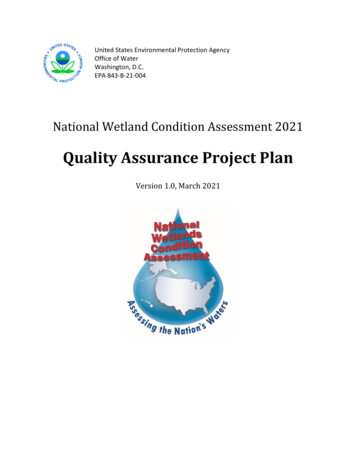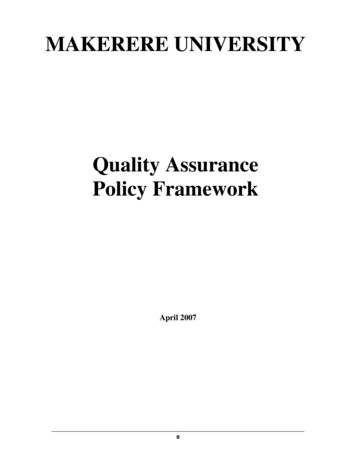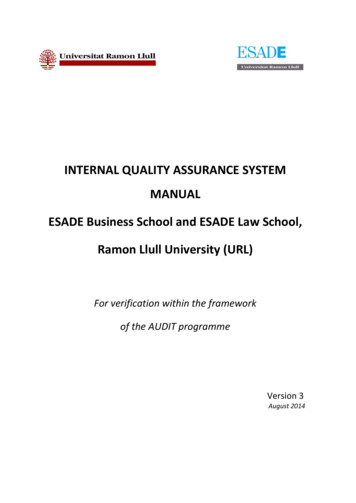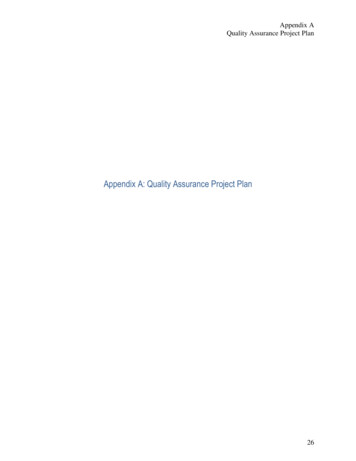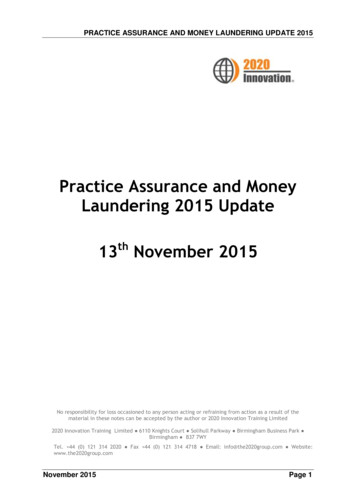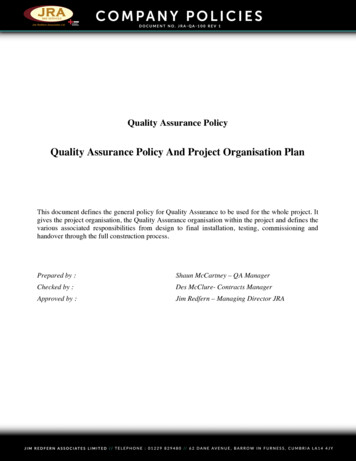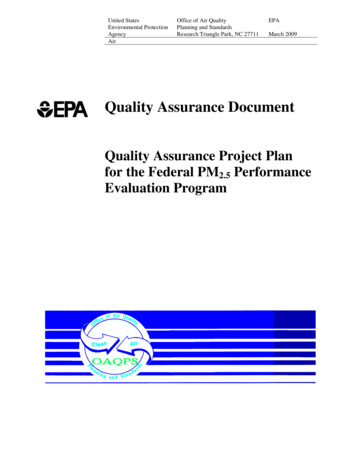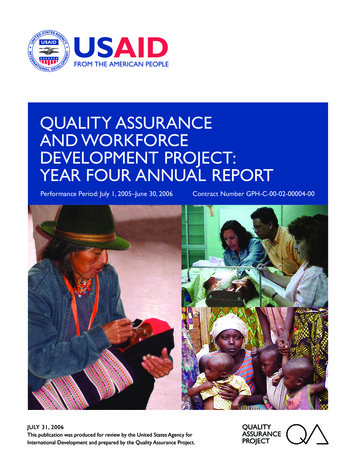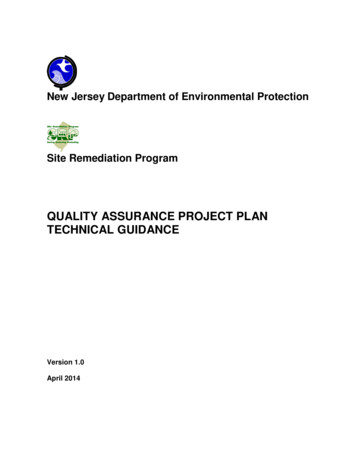
Transcription
New Jersey Department of Environmental ProtectionSite Remediation ProgramQUALITY ASSURANCE PROJECT PLANTECHNICAL GUIDANCEVersion 1.0April 2014
TABLE OF CONTENTS1Intended Use of Guidance Document . 12Purpose . 23Document Overview . 44Procedures. 54.1 Conceptual Site Model . 54.2 Data Quality Objectives . 64.3 Data of Known Quality Protocols . 94.4 Laboratory Accreditation/Certification . 114.5 NJDEP Requirements . 125QAPP Elements . 155.1 Administrative Sections . 165.1.1 Title and Approval Pages . 165.1.2 Table of Contents . 165.2 Project Definition/Background. 175.2.1 Project Definition . 175.2.2 Background . 175.2.3 Project/Task Description . 175.3 Project/Task Organization . 185.3.1 Project Team . 185.3.2 Special Training Needs/Certification . 195.4 Data Quality Objectives and Criteria for Measurement Data. 195.4.1 Precision . 205.4.2 Accuracy . 205.4.3 Representativeness . 215.4.4 Comparability . 225.4.5 Completeness . 225.4.6 Sensitivity . 235.4.7 Historical and Secondary Information / Data . 245.4.8 Investigation Process Design . 255.4.9 Investigation Methods . 265.4.10 Field Quality Control . 275.4.11 Field Instrument/Equipment Calibration and Frequency . 285.4.12 Inspection/Acceptance of Supplies and Consumables. 285.4.13 Sample Handling and Custody Requirements . 285.4.14 Field Storage and Transport Procedures. 295.5 Analytical Laboratory Requirements . 295.5.1 Project Compounds and Analytical Summary. 295.5.2 Analytical Quality Control . 315.5.3 Laboratory Deliverables . 325.6 Data Review and Usability . 335.6.1 Data Management . 335.6.2 Data Verification and Usability . 335.6.3 Reconciliation with User Requirements . 355.7 Assessments. 365.7.1 Performance and System Audits . 365.7.2 Corrective Action Processes . 375.8 Reporting, Documents and Records . 37ii
Appendix AReferences . A-1Appendix BMethod Specific DQI Tables (QAPP Worksheets . B-1Appendix CGlossary . C-1Appendix DList of Acronyms . D-1iii
1Intended Use of Guidance DocumentThis guidance is designed to help the person responsible for conducting remediation to complywith the New Jersey Department of Environmental Protection’s (Department's) requirementsestablished by the Technical Requirements for Site Remediation (Technical Rules), N.J.A.C.7:26E. Because this guidance will be used by many different people that are involved in theremediation of a contaminated site such as Licensed Site Remediation Professionals (LSRPs),Non-LSRP environmental consultants and other environmental professionals, the generic term“investigator” will be used to refer to any person who uses this guidance to remediate acontaminated site on behalf of a remediating party, including the remediating party itself.The procedures for a person to vary from the technical requirements in regulation are outlined inthe Technical Rules at N.J.A.C. 7:26E-1.7. Variances from a technical requirement or guidancemust be documented and be adequately supported with data or other information. In applyingtechnical guidance, the Department recognizes that professional judgment may result in a rangeof interpretations on the application of the guidance to site conditions.This guidance supersedes previous Department guidance issued on this topic. Technicalguidance may be used immediately upon issuance.However, the NJDEP recognizes thechallenge of using newly issued technical guidance when a remediation affected by theguidance may have already been conducted or is currently in progress.To provide for thereasonable implementation of new technical guidance, the NJDEP will allow a 6-month “phasein” period between the date the technical guidance is issued final (or the revision date) and thetime it should be used.This guidance was prepared with stakeholder input. The following people were on thecommittee who prepared this document: Greg Toffoli, Chair, New Jersey of Environmental Protection (Department), Office of DataQualityNancy Rothman, Ph.D., New Environmental Horizons, Inc.Rodger Ferguson, CHMM LSRP, Pennjersey Environmental ConsultingStuart Nagourney (Department), Office of Quality AssuranceDavid Robinson, LSRP, Synergy Environmental, Inc.Joseph Sanguiliano (Department), Office of Data QualityPhillip Worby, Accutest Laboratories, Inc.1
2PurposeThe purpose of this document is to provide guidance on the development and use of QualityAssurance Project Plans (QAPPs) associated with the remediation of sites for the New JerseyDepartment of Environmental Protection (Department) Site Remediation Program (SRP) asrequired by the Technical Rule, at N.J.A.C. 7:26E-2.2. All other applications or use of thistechnical guidance at non-SRP sites or properties is beyond the scope and authority of the SRPregulations.This document has been developed to assist Licensed Site Remediation Professionals(LSRPs), Department case reviewers and/or managers, and other environmental professionals,collectively the investigator, to obtain scientifically reproducible and reliable data, i.e., Data ofKnown Quality Protocols (DKQP), that meets the Data Quality Objectives (DQOs) establishedfor the investigation and remediation of the contaminated site. The intent of this technicalguidance is to provide guidance for investigators to address the majority of SRP sites wheredata collection is required as part of the remedial process.QAPPs are the primary result of a systematic planning process and are used to document theresults of planning, to implement environmental operations, and to assess project data. It isimportant to remember during the QAPP development process that data quality is an issuebecause of the possibility of both variability and error in sampling and analysis. The naturalenvironment is inherently variable; nothing stays the same from time-to-time or from place-toplace. In addition, all of our measurement processes are flawed to some degree, imposing erroron top of the inherent variability. The QAPP documents the results of the project’s technicalplanning process, providing a single and concise plan for the collection and management ofenvironmental data and the DQO.While making sure to cover all of the elements described herein, the investigator should not letthis guidance in any way limit the team’s investigation of alternative materials that might beuseful for understanding the substance or rationale for the project. In addition, this guidance ismost applicable to environmental monitoring projects that do not involve extensive modeling orresearch components (for modeling projects, see United States Environmental ProtectionAgency (USEPA), Guidance for Quality Assurance Project Plans, EPA QA/G-5, December2002, EPA/240/R-02/009).2
The QAPP should be prepared by the investigator in cooperation with representatives from allgroups (i.e., Investigator, Laboratory, Driller, the Department, etc.) expected to be involved inthe project. It should be completed before environmental data collection or use activities begin.When changes in the project will affect the technical or DQO of the project, the QAPP will needto be amended with notification of all project participants. QAPPs for multi-year projects shouldbe reviewed periodically and revised when necessary.This QAPP Guidance should be used in concert with other Department guidance documents,the Regulations Implementing the Underground Storage of Hazardous Substances Act(N.J.A.C. 7:14B), the Industrial Site Recovery Act (N.J.A.C. 7:26B), the Technical Requirementsfor Site Remediation (N.J.A.C. 7:26E), and other relevant and applicable regulations.Based on the professional judgment of the investigator, or as required by the Department, otherplanning documents may be utilized to develop a QAPP. Departure from this QAPP guidancewould constitute a deviation that requires justification in the next Remedial Phase (PreliminaryAssessment/Site Investigation Report, Remedial Investigation Report, Remedial ActionWorkplan and/or Remedial Action Report) submitted to the Department. Other documents whichmay be used include the following: USEPA, EPA Requirements for Quality Assurance Project Plans, EPA QA/R-5, March 2001(Reissued May 2006), EPA/240/B-01/003; USEPA, Guidance for Quality Assurance Project Plans, EPA QA/G-5, December 2002,EPA/240/R-02/009; USEPA Region II, Guidance for the Development of Quality Assurance Project Plans forEnvironmental Monitoring Projects, April 12, 2004. Intergovernmental Data Quality Task Force, Uniform Federal Policy for Quality AssuranceProject Plans, Version 2, EPA-505-B-04-900A, March 2005; CTDEP, Laboratory Quality Assurance and Quality Control Data Quality Assessment andData Usability Evaluation Guidance Document, December 2010; MADEP, MCP Representativeness Evaluations and Data Usability Assessments Policy,WSC-07-350, September 19, 2007; and MADEP, Quality Assurance and Quality Control Guidelines for the Acquisition and Reportingof Analytical Data in Support of Response Actions Conducted Under the MassachusettsContingency Plan (MCP), WSC – CAM – VII A, July 1, 2010.3
3Document OverviewThis guidance document discusses the procedures for the development and implementation ofQAPPs. Specifically, the document provides the following: Establishes the importance of the inclusion of DQOs and Data Quality Indicators (DQIs) inthe data quality framework; Establishes the importance of the use of the Conceptual Site Model (CSM) in determiningthe DQOs; Incorporates the concept of DKQPs; and Offers a framework for the investigator to assess and determine the usability of the datacollected incorporating the following documents:oDraft Laboratory Quality Assurance and Quality Control: NJDEP Data QualityAssessment and Data Usability Evaluation Guidance Document, August 2012; andoDraft Laboratory Quality Assurance and Quality Control Guidance – Data of KnownQuality Protocols, January 2012.4
4ProceduresThe QAPP integrates all technical and quality aspects of a project, including planning,implementation, and assessment. The purpose of the QAPP is to document the planning forenvironmental activities and to provide a project-specific “blueprint” for obtaining the type andquality of environmental data needed for a specific decision or use.Laboratory QA/QC is a comprehensive program used to define and document the quality ofanalytical data. QA involves planning, implementation, assessment, reporting, and qualityimprovement to establish the reliability of laboratory data. QC procedures are the specific toolsthat are used to achieve this reliability. An effective QA/QC program should identify anddocument DQOs to support the question, “What do I need to do at the site and what informationdo I need?” It establishes sampling design criteria not only to acquire representative site databut also to acquire information on the data quality indicators (DQI). The investigator shouldinclude an evaluation of the DQIs associated with each site data set to determine if the preestablished DQO was achieved.1The QAPP defines how QA and QC are applied to environmental activities to assure that theresults obtained are of the type and quality needed. The ultimate success of a remediationdepends on the quality of the environmental data collected and used in decision-making, andthis may depend significantly on the adequacy of the QAPP and its effective implementation.This technical guidance incorporates the principles of CSMs, DQOs, and DQIs to achieve DKQ.All of these principles are detailed in the sections that follow. A total program to produce DKQshould include both a QA and QC component, which encompasses the managementprocedures and controls to assess the precision, accuracy, completeness, sensitivity, andrepresentativeness of the site data set.4.1Conceptual Site ModelA Conceptual Site Model (CSM) is a written and/or illustrative representation of the conditionsand the physical, chemical and biological processes that control the transport, migration and1MADEP, Overview of the Analytical Data Enhancement Process for the Massachusetts Contingency Plan, WSCCAM, July 1, 2010.5
potential impacts of contamination (in soil, air, ground water, surface water and/or sediments) tohuman and/or ecological receptors. The CSM is an iterative tool that provides a description ofrelevant site features and the surface and subsurface conditions to understand the nature andextent of identified contaminants of concern (COCs) and the risk they may pose to identifiedreceptors. The level of detail of the CSM should match the complexity of the site and availabledata. Development and refinement of the CSM will help identify investigative data gaps in thecharacterization process and can ultimately support remedial decision-making.Initially, potential sources of contaminants are identified and investigated. These may includetanks, material transport areas, drainage conveyance areas, production areas, waste disposalareas, etc. Potential contaminants as well as their actual concentrations in the various matricesonsite including soil, sediment, surface water, groundwater, biota, and air should be fullycharacterized to understand the nature and extent of contamination and the potential forcontaminant migration. Potential migration pathways for these contaminants to receptors arethen identified and evaluated to assess exposure risks. Incomplete pathways should also beidentified.Preparation and use of the CSM is an iterative process throughout the lifecycle of the projectand should be developed with the investigator in cooperation with representatives from thegroups expected to be involved in the project. The CSM should be modified, as needed, toevaluate the relationship between sources of contaminants, migration pathways, and receptorsas new data become available. Evaluation of these three components through the completion ofthe CSM, in conjunction with initial preparation and subsequent revisions to the ReceptorEvaluation form is necessary to ensure receptors are identified and addressed.24.2Data Quality ObjectivesDQOs are developed by the investigator to ensure that a sufficient quantity of information iscollected and to ensure that the quality of the analytical data generated meet the goals of theproject and support defensible conclusions that are protective of human health and theenvironment. DQOs should be developed at the beginning of a project, revisited, and modified,if necessary, as the project progresses. Similarly, the quality of the analytical data is evaluatedin relation to the DQOs throughout the course of a project.2NJDEP, Conceptual Site Model, version 1.0, December 16, 2011.6
It is important to document the DQOs for a project in the context of the CSM so there is aroadmap to follow during the project and so there is documentation that the DQOs were metafter the project is finished. Typical analytical DQOs include, but are not limited to the following: Sensitivity DQO established by defining the reporting limit requirements for the analyticaldata. The non-detect values (i.e., reporting limits) should be reported at or below theapplicable and relevant numeric regulatory standards and/or criteria 3 as promulgated,revised, and published by NJDEP4, including but not limited to the following:oResidential Direct Contact Health Based Criteria and Soil Remediation Standards(RDC SRS), 5 http://www.nj.gov/dep/srp/regs/rs/rs rule.pdfoNonresidential Direct Contact Health Based Criteria and Soil Remediation Standards(NRDC SRS), 6 http://www.nj.gov/dep/srp/regs/rs/rs rule.pdfoDefault Impact to Groundwater Soil Screening Levels for s/partition equation.pdfoDefault Leachate Criteria for Class II Ground Water (Synthetic Precipitation LeachateProcedure); 8 http://www.nj.gov/dep/srp/guidance/rs/splp guidance.pdfoSpecific Ground Water Quality Criteria (Groundwater Quality Standards), 9http://www.nj.gov/dep/rules/rules/njac7 9c.pdfoSurface Water Quality Criteria for Toxic Substances (SWQC),10http://www.nj.gov/dep/rules/rules/njac7 9b.pdfoMaximum Contaminant Levels (MCL) for State Regulated 7 10.pdf3NJDEP, N.J.A.C. 7:26E-2.1(a)4.NJDEP, Electronic Compendium of Selected Environmental Standards, http://www.nj.gov/dep/standards/ .5NJDEP, Remediation Standards, N.J.A.C. 7:26D.6NJDEP, Remediation Standards, N.J.A.C. 7:26D.7NJDEP, Development of Site-Specific Impact to Ground Water Soil Remediation Standards Using the Soil-WaterPartition Equation, December 2008, http://www.nj.gov/dep/srp/guidance/rs/.48NJDEP, Guidance for the use of the Synthetic Precipitation Leaching Procedure to Develop Site-Specific Impact to Ground WaterRemediation Standards, June 2, 2008, http://www.nj.gov/dep/srp/guidance/rs/.9NJDEP, Groundwater Quality Standards, N.J.A.C. 7:9C.NJDEP, Surface Water Quality Standards, N.J.A.C. 7:9B.11NJDEP, Safe Drinking Water Act Regulations, N.J.A.C. 7:10.107
oNJDEP MASTER TABLE GENERIC VAPOR INTRUSION SCREENING LEVELSincluding Vapor Intrusion Groundwater Screening Levels (GWSL),12 Vapor Intrusion Residential Indoor Air Screening Level (RIASL), 13 Vapor Intrusion Nonresidential Indoor Air Screening Level (NRIASL), 14 All at vig tables.pdf oNJDEP Action Levels for Indoor usion/vig tables.pdfoVapor Intrusion Health Department Notification levels (HDNL) n/vig tables.pdfoExtractable Petroleum Hydrocarbons (EPH)17http://www.nj.gov/dep/srp/guidance/srra/eph method.pdfoHexavalent Chromium Cleanup Criterion e criteria.pdfoEcological Screening Criteria esc table.pdfosite specific criteria developed for the investigation and remediation according to theapplicable NJDEP guidance; andThe RL for a specific substance when determining the extent and degree of polluted soil,groundwater, or sediment from a release. For the purpose of this document, the RL isdefined as:oOrganics, the lowest initial calibration standard as adjusted for the dilution factor,sample weight/volume, and moisture content;oInorganics, the concentration of that analyte in the lowest level check standard(which could be the lowest calibration standard in a multi-point calibration curve).12NJDEP, Vapor Intrusion Technical Guidance, criteria dated Version 3.1 March sion/.13Ibid.14Ibid.15Ibid.16Ibid.17NJDEP, Protocol for Addressing Extractable Petroleum Hydrocarbons, Version 5.0, August 9, 2010,http://www.nj.gov/dep/srp/guidance/srra/eph protocol.pdf.18NJDEP, Chromium Soil Cleanup Criteria, April 2010.19NJDEP, Ecological Screening Criteria, March 10, 2009, http://www.nj.gov/dep/srp/guidance/ecoscreening.8
Accuracy DQO established by defining acceptance criteria (QA/QC criteria) for recovery ofanalytical spikes and instrument performance (e.g., calibrations) or the use of referencematerials; Precision DQO established by defining acceptance criteria for precision between duplicateresults (laboratory and/or field duplicates); Representativeness DQO established by defining the sampling plan, the procedures andprotocols used to collect, preserve, and transport samples, and by defining appropriatemethods for analysis; Completeness DQO established by defining the amount of valid data required for projectdecisions; and Comparability DQO defined by establishing comparable methods of sampling and analysisthroughout the project.The DQOs, which are based on the intended use of the analytical data, determine the reliabilityof the analytical data to make sound, rational decisions regarding data usability. For example,analytical data can be used by an investigator to determine if a discharge in exceedance of theNJDEP standards and/or criteria has occurred, evaluate the nature and extent of a release,confirm that remediation is complete, or determine compliance with the applicable and relevantnumeric standards and/or criteria.4.3Data of Known Quality ProtocolsIf the remedial process is to run effectively and efficiently, analytical and environmentalmonitoring data must be scientifically valid and defensible. A level of precision and accuracycommensurate with the intended use should take into consideration relevant regulations,technical guidance and LSRP's professional judgment.Many of the analytical methods used in conjunction with the remediation of sites for SRPcontain QA/QC criteria that are specified as guidance, the results of which are QA/QC criteriathat are variable and different for each laboratory (albeit QA/QC criteria that may be acceptableunder the constraints of a method). It is this variability that poses an impediment to the goal ofconsistency, especially with regard to data usability decisions. If the assessment and usabilityprocess is to work efficiently and effectively, then it is important that the analytical QA/QCfollowed is the same for all laboratories. If not, the task of creating and using a technicalguidance document that addresses the assessment and usability of data (most decisions of9
which are based on the results of laboratories’ QA/QC results) may become difficult to interpret.If data are to be assessed and used uniformly and consistently by the investigator and others,then it is beneficial to standardize the QA/QC associated with analytical methods.To this end, the Department has developed DKQP.The primary function of the DKQPs is to describe specific QA and QC procedures which, ifperformed by the laboratory, will provide analytical data of known and documented FKNOWNQUALITYCONFORMANCE/NON-CONFORMANCE SUMMARY that the laboratory may use todemonstrate whether the data meets the guidelines for “Data of Known Quality”. When “Data ofKnown Quality” are achieved for a particular data set, the investigator will have confidence thatthe laboratory has followed the DKQPs, has described non-conformances, if any, and hasadequate information to make judgments regarding data quality. This will enable the investigatorto subsequently evaluate whether the quality of the data is sufficient for its intended purpose.Key document submittals should include details regarding any known conditions or findings thatmay affect the usability of analytical data. Data that comply with the QC/QA and performancestandards detailed in the individual QAPP may be considered Data of Known Quality (DKQ).In order to achieve DKQ, the investigator should: Use the DKQP specified for the particular contaminant species and matrix analyzed; Incorporate required analytical QC elements specified in the QAPP; Implement, as necessary, required corrective actions and analytical response actions fornon-conforming analytical performance standards; Evaluate and narrate, as necessary, identified DKQPs non-compliances; and Comply with the reporting requirements specified in the Site Remediation Reform Act,Technical Rule, and/or Administrative Requirements for the Remediation of ContaminatedSites (ARCCS).Achieving DKQ status should be considered minimum requirements to assure data validity.Investigators have an obligation, to demonstrate and document an overall level of QA/QC(laboratory and field), data usability, and data representativeness adequate for the intendeduse of the data.10
Investigators who elect not to utilize the DKQP should utilize a more robust traditional datavalidation approach. In cases where DKQ is achieved, but where data are qualified as beingoutside a required QC limit (e.g., low surrogate recoveries), additional evaluation, and possiblyadditional field sampling and analysis, may be necessary. For example, the investigator maywant to collect additional post excavation samples to be satisfied that low surrogate spikerecoveries obtained in original samples are reproducible and due to sample matrix effects.However, an investigator performing an initial site investigation may consider data fromanalyses with low surrogate recoveries as “usable” if the associated data is above regulatorylimits and additional investigation is required.4.4Laboratory Accreditation/CertificationThe Department’s Office of Quality of Assurance (OQA) currently provides laboratorycertification for potable water, wastewater, soil, and air matrices according to approved methodsand individual parameters. The purpose of the laboratory certification program is to identifylaboratories in both the public and private sectors that are capable of consistently producingvalid data. The Department’s OQA is a recognized accreditation body in the NationalEnvironmental Laboratory Accreditation (NELAP) program. Towards this end, OQA evaluateslaboratories to ensure that they meet and continue to meet the performance and resourcecriteria set forth in Department’s Laboratory Certification Regulations, N.J.A.C. 7:18, regardinglaboratory personnel and qualifications, facilities, equipment, methodol
USEPA, Guidance for Quality Assurance Project Plans, EPA QA/G-5, December 2002, EPA/240/R-02/009; USEPA Region II, Guidance for the Development of Quality Assurance Project Plans for Environmental Monitoring Projects, April 12, 2004. Intergovernmental Data Qualit y Task Force, Uniform Federal Policy for Quality Assurance
